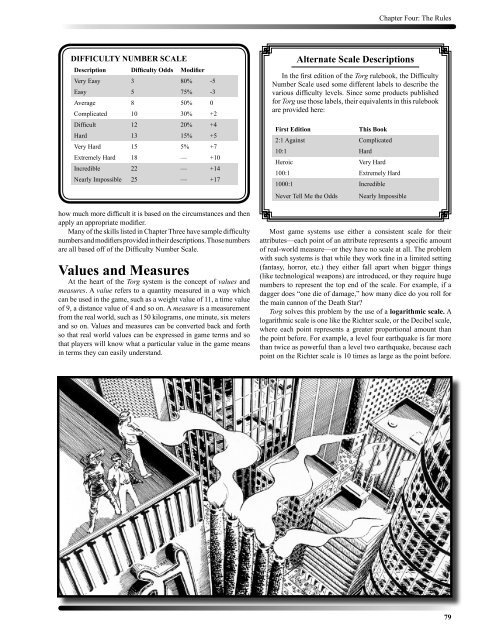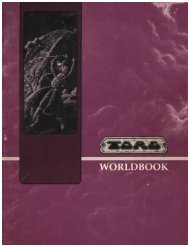Torg Player Rules
Torg Player Rules
Torg Player Rules
You also want an ePaper? Increase the reach of your titles
YUMPU automatically turns print PDFs into web optimized ePapers that Google loves.
DIFFICULTY NUMBER SCALE<br />
Description Difficulty Odds Modifier<br />
Very Easy 3 80% -5<br />
Easy 5 75% -3<br />
Average 8 50% 0<br />
Complicated 10 30% +2<br />
Difficult 12 20% +4<br />
Hard 13 15% +5<br />
Very Hard 15 5% +7<br />
Extremely Hard 18 — +10<br />
Incredible 22 — +14<br />
Nearly Impossible 25 — +17<br />
how much more difficult it is based on the circumstances and then<br />
apply an appropriate modifier.<br />
Many of the skills listed in Chapter Three have sample difficulty<br />
numbers and modifiers provided in their descriptions. Those numbers<br />
are all based off of the Difficulty Number Scale.<br />
Values and Measures<br />
At the heart of the <strong>Torg</strong> system is the concept of values and<br />
measures. A value refers to a quantity measured in a way which<br />
can be used in the game, such as a weight value of 11, a time value<br />
of 9, a distance value of 4 and so on. A measure is a measurement<br />
from the real world, such as 150 kilograms, one minute, six meters<br />
and so on. Values and measures can be converted back and forth<br />
so that real world values can be expressed in game terms and so<br />
that players will know what a particular value in the game means<br />
in terms they can easily understand.<br />
Alternate Scale Descriptions<br />
Chapter Four: The <strong>Rules</strong><br />
In the first edition of the <strong>Torg</strong> rulebook, the Difficulty<br />
Number Scale used some different labels to describe the<br />
various difficulty levels. Since some products published<br />
for <strong>Torg</strong> use those labels, their equivalents in this rulebook<br />
are provided here:<br />
First Edition This Book<br />
2:1 Against Complicated<br />
10:1 Hard<br />
Heroic Very Hard<br />
100:1 Extremely Hard<br />
1000:1 Incredible<br />
Never Tell Me the Odds Nearly Impossible<br />
Most game systems use either a consistent scale for their<br />
attributes—each point of an attribute represents a specific amount<br />
of real-world measure—or they have no scale at all. The problem<br />
with such systems is that while they work fine in a limited setting<br />
(fantasy, horror, etc.) they either fall apart when bigger things<br />
(like technological weapons) are introduced, or they require huge<br />
numbers to represent the top end of the scale. For example, if a<br />
dagger does “one die of damage,” how many dice do you roll for<br />
the main cannon of the Death Star?<br />
<strong>Torg</strong> solves this problem by the use of a logarithmic scale. A<br />
logarithmic scale is one like the Richter scale, or the Decibel scale,<br />
where each point represents a greater proportional amount than<br />
the point before. For example, a level four earthquake is far more<br />
than twice as powerful than a level two earthquake, because each<br />
point on the Richter scale is 10 times as large as the point before.<br />
79



